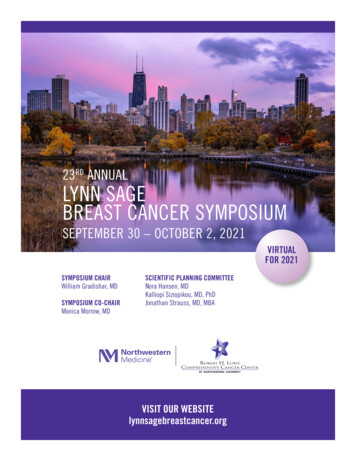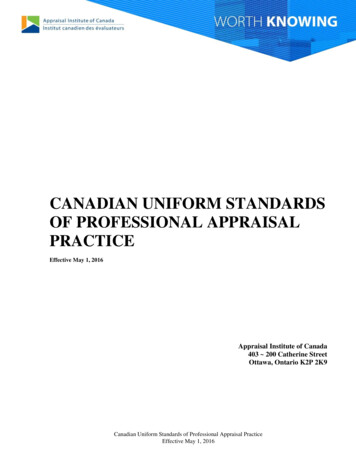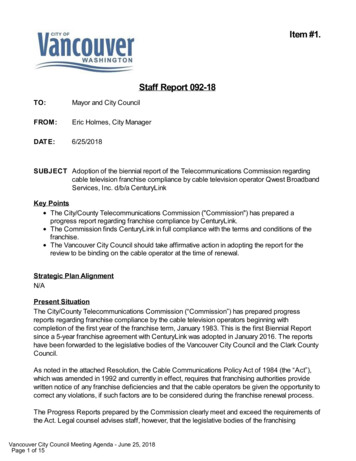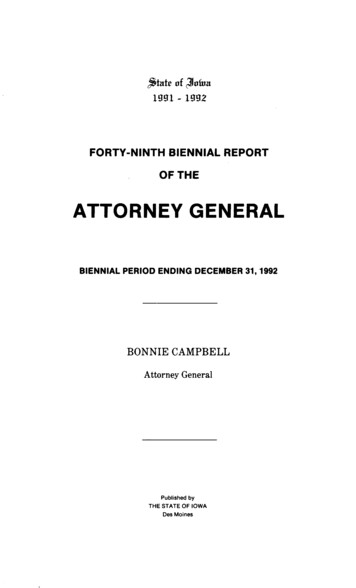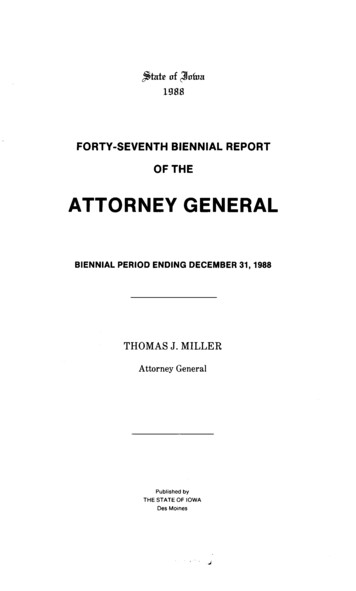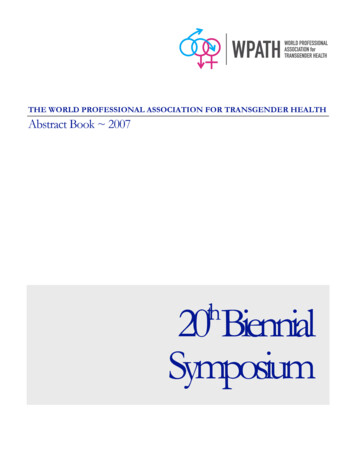
Transcription
THE WORLD PROFESSIONAL ASSOCIATION FOR TRANSGENDER HEALTHAbstract Book 2007th20 BiennialSymposium
WPATH 20TH BIENNI AL SYMPOSI UM, CHICAGO, ILLI NOI SSymposium AbstractsCompiled by Tara L. Tieso , MSW, Shellae Mueller, Dr. Bean Robinso n , PhD WPATH1300 South Second Street Suite 180Minneapolis, MN 55454Phone: 612 624 - 9397 Email: wpath@wpath.org
Table of ContentsA Message from the President 1WPATH Officers, Board of Directors & Staff 2WPATH XX Biennial Symposium Scientific Committee .3WPATH Committees . .4Posters 39 - 54Complete Alphabetical Index by Last Name .69
W P A T H 2 0 T H B I E N N I A LS Y M P O S I U M 2 0 0 7A Message from thePresidentProf. Dr. Stan MonstreyChicago, September 2007Dear WPATH Members and Symposium Participants,It is my pleasure to welcome each and every one of you to the 20th International Symposium of the WorldProfessional Association of Transgender Health (WPATH), formerly the Harry Benjamin International GenderDysphoria Association (HBIGDA).The two past meetings of our Association have been held in Europe (2003 Gent and 2005 Bologna) and it’s goodto be back in the United States in this beautiful city of Chicago.With this 20th Anniversary Symposium, our Association already has a long history to look back upon. Still, thisChicago Meeting, which will probably be one of the most important meetings in the history of our Association, isfocused on looking to the future, and this is reflected in our program in many ways.Our Association has changed its name from HBIGDA to WPATH, and this change of name reflects our newvision and our new mission. For the first time ever, a Pre-Symposium on various subjects, featuring 3 differentlevels of expertise has been organized just prior to our Meeting. Very distinguished keynote speakers will provideinformation on the newest trends, both in biological sciences and surgery. Also for the first time ever, a plenarysession will focus on the evolving field of tele-psychiatry and web-based transgender care. Other very importantplenary sessions will be held on the treatment of gender dysphoric children, evidence-based data, the state of theart in gender reassignment surgery, and new directions in our Standards of Care.The WPATH Symposium offers a unique opportunity to share information and our professional experience in thefield of gender dysphoria with other professionals from surgery, psychiatry, endocrinology, psychology, sexology,sociology, counselling, voice therapy and law as well as with clients who have experienced the ignorance anddiscrimination of society towards transgendered persons.I want to express my thanks to our staff: Dr. Bean Robinson and Tara Tieso for handling all the many facets ofthe Society over the past two years, especially in this very intense period of transition from HBIGDA to WPATH.I also would like to thank Drs. Randi Ettner and Loren Schechter for organizing such a great meeting here inChicago.I know that you will find the scientific program exceptionally stimulating and interesting and we are so pleased tosee people from all over the world who have joined us here – Welcome to Chicago!Prof. Dr. Stan MONSTREYSM/ad (WPATH.Chicago2007)1
W P A T H 2 0 T H B I E N N I A LS Y M P O S I U M 2 0 0 7WPATH Officers, Board of Directors & StaffOfficersPre si den tDr Stephen Whittle, PhD (UK)Pre si den t - Ele ctDr Walter O. Bockting, PhD, LP (USA)Secre tary - T rea sure rDr George R. Brown, MD, DFAPA (USA)Pa st - Pre si dentDr Stan Monstrey, MD (Belgium)Board of DirectorsDr Michael Brownstein, MD (USA)Dr Griet De Cuypere, MD, PhD (Belgium)Dr Lin Fraser, EdD, MFT (USA)Dr Randi Ettner, MD (USA)Dr Jamison Green, MFA (USA)Dr Cristina Meriggiola, MD, PhD (Italy)Dr Kit Rachlin, PhD (USA)StaffExecutive DirectorDr. Bean Robinson, PhD (USA)Executive AssistantTara L. Tieso, MSW (USA)2
W P A T H 2 0 T H B I E N N I A LS Y M P O S I U M 2 0 0 7WPATH XX Biennial SymposiumScientific CommitteeCo - ChairsWalter Meyer MD (USA)Stan Monstrey MD (Belgium)Dr. Stephen Whittle Ph.D. (UK)Local Organizing Committee ChairRandi Ettner PhD (USA)Jennifer Pritzer (USA)Linda Przywara MD (USA)Loren Schechter MD (USA)Vin Tangpricha MD PhD (USA)Deb Wilke (USA)MembersWalter Bockting, PhDJohn Capozuca, PhDPeggy Cohen Kettenis, PhDDomenico De Ceglie MD, FRCPsychGriet De Cuypere, MD, PhDJaime Feldman, MD, PhDLuk GijsSelma GonzalesIra Haraldsen, MDTakao Harashina, MDPiet Hoebeke, MD, PhDLoren Schechter, MDTom Mazur, PsyDHeino Meyer-Bahlburg, Dr. rer.nat.Jude Patton, PA-CFriedemann Pfäfflin, MDAnna Ravenna, PhDOliver Robinow MDCM, FRCPRobert RubensLoren Schechter, MDGuy T'Sjoen, MDChristine Wheeler, PhDStephen Whittle, PhDKevan Wylie, MDKen Zucker, PhD3
W P A T H 2 0 T H B I E N N I A LS Y M P O S I U M 2 0 0 7WPATH CommitteesWPATH Advocacy & Liaison CommitteeChairJamison Green, MFA (USA)MembersRosalynne Blumenstein, MSW (USA)Joanna Frost, MSW, LCSW (USA)Blaine Paxton Hall, BS, PA-C (USA)Debra Roth, MCSW (USA)Don Sidelinker, PhD (USA)Anne Vitale, Ph.D. (USA)WPATH Archives CommitteeChairAaron H. Devor, Ph.D. (Canada)Co-ChairLeah Cahan Schaefer, Ed.D. (USA)MembersJohn C. Capozuca, Ph.D. (USA)Armand Hotimsky (France)Christine Wheeler, Ph.D. (USA)WPATH Child & Adolescent CommitteeChairDomenico DeCeglie, M.D. (UK)WPATH Ethics CommitteeChairMichael Brownstein, M.D. (USA)MembersDebra Roth, M.C.S.W. (USA)William A. Henkin, Ph.D. (USA)4
W P A T H 2 0 T H B I E N N I A LS Y M P O S I U M 2 0 0 7Disorders of Sexual Development CommitteeChairTom Mazur, Psy.D. (USA)MembersProfessor Dr. Hertha Richter-Appelt (Germany)Peggy Cohen-Kettenis, Ph.D.(The Netherlands)Dr.rer.nat. Heino F.L. Meyer-Bahlburg (USA)Walter Meyer III, M.D. (USA)Norman P. Spack, M.D. (USA)Ken Zucker, Ph.D. (Canada)WPATH Legal Issues CommitteeChairAlyson Dodi Meiselman, Esq. (USA)MembersJamison Green, M.F.A. (USA)WPATH Membership and Website CommitteeChairStephen Whittle, Ph.D. (UK)WPATH Symposium Local Organizing CommitteeChairRandi Ettner Ph.D. (USA)MembersJennifer Pritzer (USA)Linda Przywara M.D. (USA)Loren Schechter M.D. (USA)Vin Tangpricha M.D. Ph.D. (USA)Deb Wilke (USA)WPATH Standard of Care Revision CommitteeChairEli Coleman, Ph.D. (USA)5
W P A T H 2 0 T H B I E N N I A LS Y M P O S I U M 2 0 0 7WPATH Transgender, Medicine, Research Discussion,STD & Blood Born Disease CommitteeChairJamie Feldman, M.D., Ph.D. (USA)MembersMichael van Trostenburg, M.D. (Austria)Shaun Tregoning (Canada)Evan Eyler, M.D. (USA)Don Sidelinker, Ph.D. (USA)Gail Bearman, M.D. (Australia)Dr. Sherman Leis (USA)Mireille Bonierbale, M.D. (France)Tarynn M. Witten, Ph.D., VCU, CSBC (USA)Dr. Richard Adler, Ph.D., C.C.C., S.L.P., F-ASHA (USA)6
W P A T H 2 0 T H B I E N N I A LS Y M P O S I U M 2 0 0 7SYMPOSIUMTHURSDAY, SEPTEMBER 6, 2007SALONS A - DWelcome and Introduction: Dr. Randi Ettner, PhDThe opening speech welcomes all the attendees (the number of participants for this Chicago Meeting is at an all time high).The local organizing committee, mainly Dr. Randi Ettner and Dr. Loren Schechter are to be thanked for the efforts theyput in organizing this meeting. An overview will be provided on the various speakers and sessions of this symposium aswell as on the city of Chicago. Last but not least, information will be given on the strategic planning meeting held in NewYork in January 2006 which resulted in the development of a new vision and mission statement and also in the transition ofHBIGDA to WPATH.Invited Speaker: Evolution’s Rainbow: Diversity, gender and sexuality in nature and people(Dr. Joan Roughgarden, PhD)Dept of Biological SciencesStanford University, Stanford CA 94305: joan.roughgarden@stanford.eduThe biological theory of gender traces to Darwin's writings on "sexual selection" in 1871. This theory of universal gendernorms and family social dynamics now appears both false and unfixable. The empirical generalizations Darwin claimed havebeen refuted by thousands of exceptions, well-known cases that seemed to fit sexual-selection's explanations do not supportthe theory when closely studied, and the theory itself contains logical contradictions in light of today's population genetics.I have proposed "social-selection" theory as a replacement for sexual-selection theory. I will review some aspects of thisnew approach to the evolution of gender, sexuality, and family social dynamics. The theory of social selection draws on themathematics of cooperative game theory.Joan Roughgarden is a professor of biological sciences and geophysics in the School of Humanities and Sciences and former director ofthe Earth Systems Program. She joined the Stanford faculty in 1972. Her main research subject is theoretical ecology andevolutionary biology, with continuing field studies of the Anolis lizards of the Lesser Antilles and previous field studies with thebarnacle populations of the California coast. Her recent research includes theoretical aspects of the interface between ecology andeconomics, and the evolution of gender expression and sexuality. She was a Guggenheim Fellow in 1985-86, elected as a Fellow ofthe American Academy of Arts and Sciences in 1993, and received Stanford's Dinkelspiel Award for service to undergraduateeducation in 1995. Her 2004 book, Evolution's Rainbow, published by the University of California Press received the StonewallPrize from the American Library Association in 2005. Her most recent book, Evolution and Christian Faith, was published in2006 by Island Press.Invited Speaker: Surgery – Overview and State of the Art (Dr. Stan Monstrey, MD)In this presentation an overview will be given on were we stand as to gender reassignment surgery, both in female to maleand male and female transsexuals. Special emphasis will be given to the residual unsolved problems in these operativeinterventions. Finally, information will be provided on the different threats related to sex reassignment surgery : diminutionof financial means and resources of the National Health Systems, quality control, the continuing dilemma of reconstructiveversus aesthetic surgery, multidisciplinary teams, training and research.Invited Speaker: The History of Christine Jorgensen (Dr. R.F. Docter, PhD)Professor of Psychology (Emeritus) California State University, Northridge17162 Sunburst Street, Northridge, CA 91325, (818) 349-9709 RichDocter@aol.comIn 1952 Christine Jorgensen became an over-night celebrity when her so-called “sex change” was depicted worldwide innewspapers and newsreels. In order to understand this case more fully, we have written a biography that attempts todistinguish fact from fiction. This study was based on the resources of several libraries, interviews with childhood friendsand close relatives, and with the assistance of those who knew her best as an adult. An especially valuable account of hertwo years in Copenhagen was provided by Jesper Hamburger, the son of her principle physician.Jorgensen was especially mis-leading concerning the following:a) Christine put forth her theory that she was the victim of some vaguely described intersex condition. In some interviewsshe alluded to findings by her physicians of what she called female tissue. These assertions were not true.b) Jorgensen denied a history of childhood cross dressing. This was not true.7
W P A T H 2 0 T H B I E N N I A LS Y M P O S I U M 2 0 0 7c) She frequently misrepresented her 1952 passport as classifying her as a female. This was not true. At that time, USpassports did include identification by sex.d) Christine sought to conceal her complicity in bringing her so-called “sex change” to the attention of the press, claimingthe story had been “leaked” by a dis-loyal friend. The true story is more complicated, but there is evidence that she wasinvolved.e) Following her emergence as a woman in 1952, she was often asked about the effects of two years of female hormones.She greatly mis-represented these facts especially concerning breast development. In 1953 she had virtually no breastdevelopment.f) When responding to the media, Jorgensen never provided an accurate account of the outcome of her three unsuccessfulsurgical attempts to construct a vagina. Despite these difficulties, she invariably told reporters that she was fully capable ofevery aspect of female sexuality.g) In general, Christine was a very well liked person with many friends. Major personality features included interpersonalwarmth, exceptional humor, extroversion, focused striving for success, and high level of aspiration. She was an excellentpublic speaker. However, persistent indications of borderline personality characteristics were also evidenced, including:several intense love-hate relationships, episodes of anger and rejection toward those who had assisted her, and unrewardingefforts to punish supposed wrongdoers through legal initiatives.Jorgensen never married. She died of cancer in 1989, and is remembered as an influential role model of transsexuality.Dr. Docter continues to be active as a gender researcher and clinician serving transgender clients.Invited Speaker: First Facial Transplant (Dr. Benoit Lengelé, MD)“Living a new face” :an update on the techniques,functional results and ethicalissuesof the first human facetransplantationThe first human face transplantation was carried out nearly two years ago now in order to reconstruct the facial appearanceof a young woman severely disfigured after a dog bite.The news of this groundbreaking procedure raised immediately many questions and concerns all over the world, not only interms of science, about the medical planning and the expected outcomes of this successful operation, but also in terms ofethics, about the potential risks runned by the patient due to the necessity for her to reappopriate psychologically the facegraft, and to sustain a life-long immunosuppressive treatment. Nevertheless, immediate impressive results that were shownalso induced a new hope for many patients suffering from a wide range of acquired or inborn body defects that could berepaired by similar composite tissue transplantations.From our present retrospective experience, based on a 22 months follow-up, we may state that face composite tissuetransplantation is feasible and that graft rejection can be overcome with a standard immunosuppressive treatment.Furthermore, if careful motor and sensitive nerve anastomoses are performed during surgery, the face graft recovers fullythe complexity of its expressive function, and its psychological reintegration deep inside the brain cortex parallels thesensitive recovery taking place simultaneously on the skin surface of the transplant. Finally, even if the surgical procedure isobviously not aiming to restore exactly the previous face image of the recipient patient, the new face that is created recoversa real individual morphology.All these inaugural data, cumulated with those collected from similar observations made on hand transplanted patients,seem to indicate by analogy that, in the future, other functional composite tissue grafts, like for example penile transplants,may be carried out successfully, although their definitive feasibility still need to overcome a lot of specific technicalproblems.8
W P A T H 2 0 T H B I E N N I A LS Y M P O S I U M 2 0 0 7(GID) - The Dutch ExperienceSchagen, SEE & Wouters FM , Cohen-Kettenis PT , Delemarre-van de Waal HA1121VU University Medical Center, Departments of Pediatric Endocrinology1 and Medical Psychology2.PO Box 7057, 1007 MB Amsterdam, The Netherlands.S.Schagen@vumc.nlTranssexual adolescents are eligible for suppression of the endogenous puberty by a GnRH-analogue, when they fulfilDSM-IV criteria for GID and have experienced the early, reversible phases of their biological puberty. This is assessed onthe basis of their Tanner stage (at least B2/ G2-3) and sex steroid hormone level. Treatment with a GnRH-analogue allowsfor a balanced decision regarding sex reassignment without the pressure of the development of irreversible secondary sexcharacteristics. If there are no contra-indications cross-sex hormones will be given from the age of sixteen.Currently, sixty patients are being treated with a GnRH analogue with a mean duration of 17,9 months (range 0-48 months).In thirty-seven cross-sex hormones were added with a mean duration of 17,6 months (range 0-45 months). By using theGnRH-analogue a decrease in height growth and bone maturation is observed. This decrease in height growth enables us tomanipulate patient’s height. The administration of high doses of estrogens inhibits growth in tall male-to-femaletranssexuals, whereas the addition of oxandrolone is used to achieve an appropriate ‘male’ height. During suppression ofpuberty bone mass stabilizes, while a catch-up of bone density is observed when cross-sex hormones are started. Still, longterm consequences have to be evaluated carefully.The effects of this treatment in regard to brain functioning and brain development will be investigated as well. Hereby thefocus will be on sex differences between transsexual adolescents and similar aged individuals of both sexes as well as onpossible neurobiological determinants of GID by means of structural and functional MRI and family pedigree research.Effects of GNRH Analogue Treatment to Delay Puberty: Effects on Psychological Functioning at16 YearsDe Vries ALC , Steensma ThD , Cohen-Kettenis P T122VU University medical center, Departments of medical psychology2 and child psychiatry1.PO Box 7057, 1007 MB, Amsterdam, the Netherlands,alc.devries@vumc.nlAt the Amsterdam VU medical centre, adolescents with GID under the age of 16 may be eligible for treatment with GnRHanalogues to arrest the development of secondary sex characteristics. Eligibility is assessed in an extensive diagnosticprocedure. For a study evaluating psychological and social functioning after GnRH treatment, adolescents who had receivedGnRH analogues were assessed twice: At their attendance to the gender identity clinic (t0) and shortly before starting crosssex hormones, usually around the age of 16 (t1). At the moment, 66 adolescents with GID (mean age at first assessment14,2 years) have been eligible for treatment with GnRH analogues, 32 female-to-males and 34 male-to-females. Thirty-nineof them have started cross-sex hormone treatment subsequently (mean age at start cross-sex hormones; 16,6 years).Twenty-six parents of these 39 individuals filled out a Child Behavior Checklist (CBCL) at both assessments. The YouthSelf Report (YSR) and other instruments measuring depressive symptoms, anxiety, anger and self-esteem were alsoadministered. The results were generally favorable. For instance, the mean total problem scores on the CBCL were not inthe clinical or sub-clinical range at either t0 or t1. Nevertheless, there was a significant decrease on total problem behavioras well as on several CBCL subscales. These results and the results with regard to the other instruments will be discussed.A Follow-Up Study of Girls with Gender Identity DisorderZucker, K. J., Drummond, K. D., Bradley, S. J., and Peterson-Badali, M.11,212Gender Identity Service, Centre for Addiction and Mental Health,2Ontario Institute for Studies in Education of theUniversity of Torontoc/o , 250 College St., Toronto, Ontario M5T 1R8, Canada; e-mail: Ken Zucker@camh.net1This study provided information on the natural history of 25 girls with gender identity disorder (GID). Standardizedassessment data in childhood (M age at assessment, 8.88 years; range, 3-12) and at follow-up (M age at follow-up, 23.24years; range, 15-36) were used to evaluate gender identity, sexual orientation, and general behavioral problems andpsychiatric disorders. At follow-up, 3 (12%) participants were judged to have persistent GID or gender dysphoria.Regarding sexual orientation, 8 (32%) participants were classified as bisexual/ homosexual in fantasy and 6 (24%) wereclassified as bisexual/homosexual in behavior. The remaining participants were classified as either heterosexual or asexual.The rates of GID persistence and bisexuality/homosexuality were substantially higher than base rates in the general femalepopulation derived from epidemiological or survey studies. About half of the participants had clinical range behavioral andpsychiatric problems at follow-up. The high rate of behavioral and psychiatric disorder at follow-up was considered inrelation to both general and specific risk factors, including the role of social ostracism related to cross-gender identificationand a minority sexual orientation.9
W P A T H 2 0 T H B I E N N I A LS Y M P O S I U M 2 0 0 7Prediction of Adult GID: A Follow-Up Study of Gender Dysphoric ChildrenWallien, MSC; Cohen-Kettenis – PhD, PTVU University Medical Center, Department of medical psychologyP.O Box 7057, 1007 MB Amsterdam, the Netherlands; P.T. Cohen-Kettenis, Phone: 00-31-20-444-2550, Fax: 00-31-20444-3077, PT.Cohen-Kettenis@vumc.nlM.S.C. Wallien, Phone: 00-31-20-444-3343, Fax: 00-31-20-444-3077, m.wallien@vumc.nlIn this study we followed children with GID into adolescence and adulthood to find childhood characteristics that predictaspects of psychosexual outcome. In childhood, we assessed a group of 77 children, who are now 16 years or older. Fiftyfour participated in the study. Twenty-seven percent of the initial sample of children referred to the Gender Identity Clinicstill fulfilled criteria for GID at follow-up: one out of five boys and half of the girls. It appeared that the most stronglygender dysphoric group in childhood still was gender dysphoric at follow-up. Extremeness of gender dysphoria was evidentfrom the percentage having a complete GID diagnosis, and the mean scores on the Gender Identity Interview (GII), theGender Identity Questionnaire for children (GIQC) and the gender items of the Child Behavior Checklist (CBCL).Scoreson the GII were a strong predictor for persisting gender dysphoria into adolescence or young adulthood. This study is thefirst one providing evidence that extremeness of childhood GID is related to persisting gender dysphoria after puberty.Invited Speaker: Symposium on Children and Adolescents (Dr. Peggy Cohen-Kettenis,PhD)Schagen, SEE1& Wouters FM1, Cohen-Kettenis PT2, Delemarre-van de Waal HA1VU University Medical Center, Departments of Pediatric Endocrinology1 and Medical Psychology2.PO Box 7057, 1007 MB Amsterdam, The Netherlands. S.Schagen@vumc.nlTranssexual adolescents are eligible for suppression of the endogenous puberty by a GnRH-analogue, when they fulfilDSM-IV criteria for GID and have experienced the early, reversible phases of their biological puberty. This is assessed onthe basis of their Tanner stage (at least B2/ G2-3) and sex steroid hormone level. Treatment with a GnRH-analogue allowsfor a balanced decision regarding sex reassignment without the pressure of the development of irreversible secondary sexcharacteristics. If there are no contra-indications cross-sex hormones will be given from the age of sixteen.Currently, sixty patients are being treated with a GnRH analogue with a mean duration of 17,9 months (range 0-48 months).In thirty-seven cross-sex hormones were added with a mean duration of 17,6 months (range 0-45 months). By using theGnRH-analogue a decrease in height growth and bone maturation is observed. This decrease in height growth enables us tomanipulate patient’s height. The administration of high doses of estrogens inhibits growth in tall male-to-femaletranssexuals, whereas the addition of oxandrolone is used to achieve an appropriate ‘male’ height. During suppression ofpuberty bone mass stabilizes, while a catch-up of bone density is observed when cross-sex hormones are started. Still, longterm consequences have to be evaluated carefully.The effects of this treatment in regard to brain functioning and brain development will be investigated as well. Hereby thefocus will be on sex differences between transsexual adolescents and similar aged individuals of both sexes as well as onpossible neurobiological determinants of GID by means of structural and functional MRI and family pedigree research.Invited Speaker: Children of Transsexuals (Dr. Randi Ettner, PhD)Ettner, R. and White, T.New Health Foundation Worldwide1214 Lake Street, Evanston, Illinois, USA: email: RETTNER@aol.comApproximately 70% of male-to-female transsexuals who enter treatment are parents. A previous study by the authorsassessed the data collected on 2,504 such individuals undergoing gender reassignment. In that study, it was confirmed thatgender transition in a parent is not a neutral event in the life of the child. Furthermore, specific age-related variables wereidentified that served as risk or protective factors in the adjustment of these children. With the exception of Green (1978,1998), and a case study of one child (Sales, 1995), there is no literature systematically addressing the progressive andregressive components of adaptation in these children. The present study, therefore, is an attempt to focus on the childrenthemselves, and as such, is a retrospective analysis. Fifty-five children were identified who had a transsexual parent. Thetransitioned parent was interviewed, and data was attained on multiple parameters. Additionally, the authors saw 25% of thechildren. Both the immediate and long-term relationship between both parents and the child was explored. In addition,variables such as gender of the child, presence of a pre-existing psychiatric disturbance, shame affect arousal in peerrelations, variables of temperament, and support from extended family, among other variables, were analyzed. It washypothesized that cooperation between parents, or at least a lack of conflict, would improve adjustment in the child. It wasalso hypothesized that children who had extended family support, who were extroverted in temperament, and those whodisclosed to peers, would have a better overall adjustment. Each child was assigned an adjustment score based on measuresacross several domains, including decrement in school performance, social stigmatization, current relationship with theparent, and fear of embarrassment. The results identify certain variables that predict overall adjustment, but underscore theextreme variability in the way children ultimately adapt to this highly anomalous life situation. Previously reported resiliencyfactors, which seem applicable to other trauma or unusual life events, fail to adequately predict adaptation in this cohort.Indeed, the best predictor of long-term adjustment in the child is the nature of the relationship with the transsexual parentat the time of the gender transition.10
W P A T H 2 0 T H B I E N N I A LS Y M P O S I U M 2 0 0 7Parallel SessionsThursday, September 6, 2007Surgery Sessions - FTMModerators: Dr. Piet Hoebeke, ND, PhD &Dr. Michael Brownstein, MDCombined Buccal Mucosa Graft and Local Flaps for Urethral Reconstruction in FemaleTranssexualsDjordjevic - MD, M; Perovic, S; Korac, G; Bizic, M; Majstorovic, MSchool of Medicine, University of Belgrade, SerbiaDepartment of Urology, Tirsova 10, Belgrade, Serbia, 11000, e-mail: djordjevic@uromiros.com, cell: 381 63 380 282, fax: 381 11 301 6380Purpose: Metoidioplasty is a variant of phalloplasty in female transsexuals allowing voiding while standing. Urethroplastypresents the most difficult part in this reconstruction. We evaluated using of buccal mucosa graft combined with the localskin flap for urethral reconstruction.Material and methods: Between July 2003 and October 2006, metoidioplasty was performed in 47 patients (aged 18 to 55years). The buccal mucosa was grafted on the tunica albuginea of the clitoris. The distal part of mucosa was sutured to theglans, and the proximal end was sutured to the native urethral meatus. Well vascularized fasciocutaneous flap was harvestedfrom labia minora or dorsal clitoral skin and sutured to the buccal mucosa to form the neourethra. Proximal part wasanastomosed to the native urethral meatus. Distally, new urethral meatus was created using double faced technique. Newurethra was covered with well vascularized subcutaneous flaps harvested from remaining labia minora and both labiamaiora. Reconstruction of the lengthened and straightened clitoris was performed using available clitoral skin. Labia maiorawith testicle implants were joined to create normal scrotal appearance.Results: Urinary stream and penile shape were satisfactory in 41 cases. Urethral fistula occurred in 9 cases, closingspontaneously in 3 cases. The other six cases required secondary repair 6 months later. One case with distal urethral stenosiswas cured by periodic urethral dilation during a three months period.Conclusion: Combined buccal mucosa graft and local flaps represent good choice for urethral reconstruction, especially dueto complication rate less than previously reported results.Musculocutaneous Latissimus Dorsi Free Transfer Flap for Total Phalloplasty in FemaleTranssexualsPerovic, S; Djordjevic - MD, M; Stanojevic, DBelgrade Gender Dysphoria Team, Belgrade, SerbiaMiroslav Djordjevic, MD, Ass. Professor of Urology/Surgery, Department of Urology, Tirsova 10, Belgrade, Serbia, 11000,e-mail: djordjevic@uromiros.com, cell: 381 63 380 282fax: 381 11 301 6380Introduction: Phalloplasty is a surgical project posing considerable challenges. There are many alternatives to this procedure(groin flap, forearm flap, rectus flap, etc). Our preference is latissimus dorsi flap because of good size of the neophallus.Methods: From April 2001 till October 2006 total phalloplasty was performed on 33 female transsexuals aged between 19 54 years. A musculocutaneous latissimus dorsi free flap was harvested with thoracodorsal artery, vein and nerve. The flapwas transferred to the pubic region and anastomozed to the femoral artery, saphenous vein and ilioinguinal nerve.Urethroplasty was performe
focused on looking to the future, and this is reflected in our program in many ways. Our Association has changed its name from HBIGDA to WPATH, and this change of name reflects our new vision and our new mission. For the first time ever, a Pre-Symposium on various subjects, featuring 3 different


